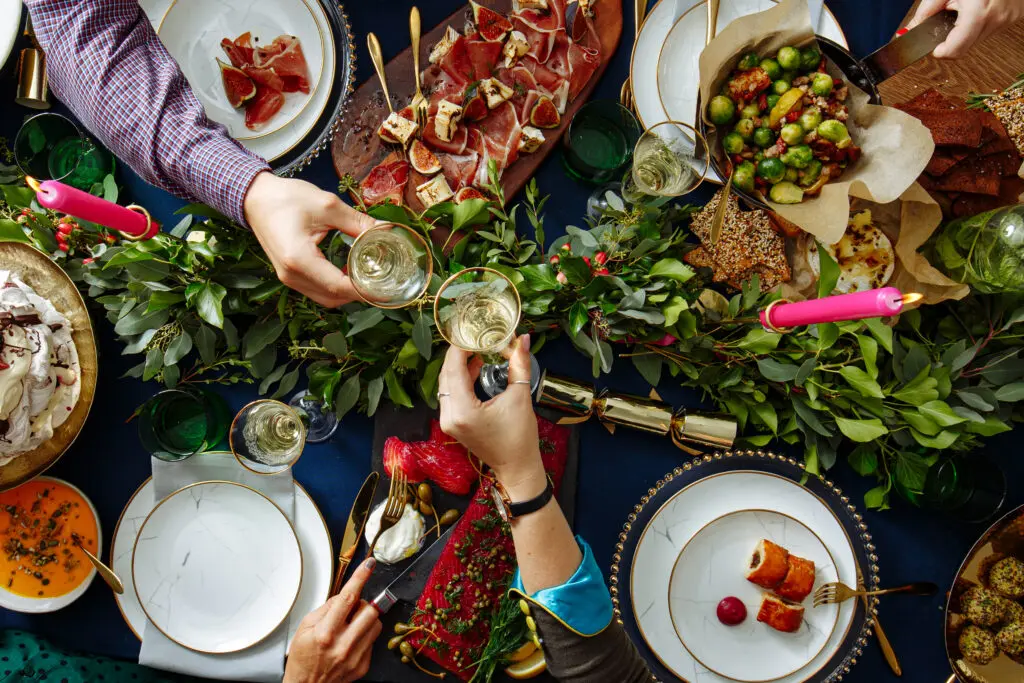This informative piece delves into the foundational principles of festive meals, exploring how to honor cultural traditions while promoting health and well-being through nutritious celebratory dishes.
Learn strategies for incorporating healthier ingredients, reducing sugar and salt intake, and practicing mindful eating without compromising the joyous spirit of special occasions. Embrace the rich traditions of festive meals while prioritizing your overall well-being with this comprehensive guide.
Key Takeaways
- Festive meals play a vital role in fostering social cohesion and creating a sense of belonging.
- Modifying traditional recipes can make them healthier without compromising taste or tradition.
- Incorporating seasonal ingredients enhances the nutritional value and flavor of festive meals.
- Balancing indulgence and moderation is crucial for maintaining a healthy balance during festive meals.
Understanding the Importance of Festive Meals
Festive meals hold a significant place in cultures around the world, serving as a means of fostering social cohesion and a sense of belonging. These special meals provide an opportunity for families and communities to come together, celebrate, and create lasting memories. They often incorporate traditional recipes and cooking techniques that have been passed down through generations, reinforcing cultural identity and heritage.
Beyond their cultural significance, festive meals also play a role in promoting physical and mental well-being. Sharing a meal with loved ones can reduce stress, increase feelings of happiness, and strengthen interpersonal relationships. Additionally, these meals often feature a variety of nutritious foods, such as fruits, vegetables, and lean proteins, which contribute to a balanced diet and support overall health.
In today’s fast-paced world, where individuals may feel disconnected and isolated, festive meals offer a chance to reconnect and forge meaningful connections. By understanding the importance of these meals and actively participating in their creation and enjoyment, individuals can enhance their sense of belonging and overall well-being.

Traditional Recipes With a Healthy Twist
Integrating traditional recipes with a healthy twist enhances the nutritional value of festive meals. By making simple modifications to traditional recipes, we can create healthier versions without compromising on taste and tradition.
Here are three ways to give your favorite festive recipes a healthy makeover:
- Swap unhealthy ingredients: Replace ingredients high in saturated fats, such as butter and cream, with healthier alternatives like olive oil, Greek yogurt, or pureed fruits. This reduces the overall calorie and fat content of the dish while still maintaining its flavor and texture.
- Increase the vegetable content: Add more vegetables to your traditional recipes to boost their nutritional value. Incorporate colorful vegetables like spinach, bell peppers, or carrots into stews, casseroles, or side dishes. Not only do they add vitamins, minerals, and fiber, but they also enhance the visual appeal of the dish.
- Opt for whole grains: Replace refined grains with whole grains in recipes like bread, stuffing, or pilaf. Whole grains provide more fiber and nutrients compared to their refined counterparts. Try using whole wheat flour, brown rice, or quinoa to add a nutty flavor and improve the nutritional profile of your festive meals.
Incorporating Seasonal Ingredients for Nutritional Benefits
How can you incorporate seasonal ingredients into your festive meals to maximize their nutritional benefits? Seasonal ingredients not only add freshness and flavor to your meals but also provide a range of health benefits. By incorporating these ingredients, you can ensure that your festive meals are both delicious and nutritious.
One way to incorporate seasonal ingredients is to plan your menu around what is available during that time of year. For example, in the summer, you can include fresh fruits and vegetables like berries, tomatoes, and zucchini, which are packed with vitamins, minerals, and antioxidants.
Another way is to explore new recipes that highlight seasonal ingredients. This allows you to experiment with different flavors and textures while reaping the nutritional benefits. For instance, you can make a hearty winter soup using seasonal root vegetables like carrots, parsnips, and sweet potatoes, which are rich in fiber and essential nutrients.
Lastly, consider incorporating seasonal ingredients into traditional dishes. This not only adds a unique twist to your festive meals but also enhances their nutritional value. For instance, you can add roasted Brussels sprouts or butternut squash to your Thanksgiving stuffing, providing additional vitamins and minerals.
Incorporating seasonal ingredients into your festive meals is a great way to maximize their nutritional benefits while celebrating tradition. It allows you to create meals that are not only delicious but also nourishing, providing a sense of belonging and satisfaction to both you and your loved ones.
Balancing Indulgence and Moderation During Festive Meals
To maintain a healthy balance during festive meals, it is important to practice indulgence in moderation. While it is natural to want to indulge in delicious and decadent foods during special occasions, it is also crucial to be mindful of our overall health and well-being.
Here are three strategies to help you strike a balance between indulgence and moderation during festive meals:
- Portion control: Instead of piling your plate high with large servings of rich foods, try to enjoy smaller portions of your favorite dishes. This allows you to satisfy your cravings without overloading your body with excessive calories and fat.
- Mindful eating: Take the time to savor and enjoy each bite. Pay attention to the flavors, textures, and aromas of the food. This practice not only enhances your dining experience but also helps you recognize when you are full, preventing overeating.
- Balance your plate: Fill your plate with a variety of nutrient-dense foods such as fruits, vegetables, lean proteins, and whole grains. This ensures that you are getting a good balance of essential nutrients while still indulging in your favorite festive treats.
Mindful Eating Strategies for Enjoying Festive Meals Guilt-Free
To fully enjoy festive meals without guilt, it is essential to employ mindful eating strategies. Mindful eating is a practice that involves paying attention to the present moment and being fully aware of your thoughts, feelings, and sensations while eating. By practicing mindful eating during festive meals, you can create a positive and balanced relationship with food.
Here are some strategies to help you enjoy your festive meals guilt-free:
- Slow down: Take your time to savor each bite and chew your food thoroughly. This will not only help you appreciate the flavors but also give your brain enough time to register when you are full.
- Listen to your body: Pay attention to your hunger and fullness cues. Eat until you feel satisfied, not overly stuffed.
- Choose nutrient-dense foods: Incorporate a variety of fruits, vegetables, lean proteins, and whole grains into your festive meals. This will ensure that you are getting essential nutrients while enjoying the flavors.
- Practice portion control: Be mindful of your portion sizes and avoid overeating. Use smaller plates and bowls to help control the amount of food you consume.
- Be mindful of your emotions: Festive meals can trigger various emotions, such as stress or nostalgia. Be aware of how your emotions may influence your eating habits and find alternative ways to cope with them.
Creating a Sustainable and Eco-Friendly Festive Meal Experience
Continuing the exploration of mindful eating strategies, the next aspect to consider when creating a healthy festive meal experience is the importance of incorporating sustainability and eco-friendly practices. By implementing sustainable practices, you not only contribute to the well-being of the planet but also promote a sense of belonging and connection to the natural world.
Here are three key ways to create a sustainable and eco-friendly festive meal experience:
- Choose locally sourced ingredients: Opt for locally grown fruits, vegetables, and meats to support local farmers and reduce the carbon footprint associated with transporting food long distances.
- Reduce food waste: Plan your meals carefully to minimize food waste. Use leftovers creatively or donate excess food to local food banks or shelters.
- Use eco-friendly utensils and tableware: Avoid single-use plastic cutlery and plates by using biodegradable or reusable alternatives such as bamboo or stainless steel.
Frequently Asked Questions
What Are Some Traditional Festive Recipes That Can Be Made Healthier?
There are several traditional festive recipes that can be made healthier without sacrificing flavor.
For example, instead of using heavy cream in mashed potatoes, you can substitute it with low-fat milk or Greek yogurt.
Another option is to roast vegetables instead of frying them, which reduces the amount of oil used.
Additionally, you can use whole wheat flour or almond flour instead of white flour in baking recipes.
These small changes can make a big difference in the nutritional content of festive meals.
How Can Seasonal Ingredients Be Incorporated Into Festive Meals for Added Nutritional Benefits?
Seasonal ingredients can be incorporated into festive meals to provide added nutritional benefits. By using fresh fruits and vegetables that are in season, you can ensure that your meals are packed with vitamins, minerals, and antioxidants.
Additionally, seasonal ingredients often have a better flavor and texture, making your dishes more enjoyable. Consider incorporating seasonal produce into salads, side dishes, and main courses to create a healthier and more balanced festive meal.
What Are Some Strategies for Finding Balance Between Indulgence and Moderation During Festive Meals?
When it comes to festive meals, finding a balance between indulgence and moderation can be challenging. However, there are several strategies that can help.
Firstly, portion control is key. Instead of loading up your plate with large servings, opt for smaller portions and savor each bite.
Secondly, incorporating healthier ingredients into traditional recipes can make a significant difference. This could include using whole grains, lean proteins, and plenty of fruits and vegetables.
Lastly, staying mindful of your overall intake and listening to your body’s hunger and fullness cues can help prevent overindulging.
How Can Mindful Eating Be Practiced to Enjoy Festive Meals Without Feeling Guilty?
Mindful eating can be practiced to enjoy festive meals without feeling guilty by focusing on the present moment and paying attention to the sensory experience of eating. This involves savoring each bite, chewing slowly, and being aware of hunger and fullness cues.
Additionally, it is important to listen to your body and eat until you are satisfied, rather than overindulging. By practicing mindfulness during festive meals, individuals can maintain a healthy balance between enjoying the traditions of the occasion while also prioritizing their nutritional well-being.
What Are Some Ways to Create a Sustainable and Eco-Friendly Festive Meal Experience?
Creating a sustainable and eco-friendly festive meal experience involves several key strategies.
First, consider sourcing ingredients locally and seasonally to reduce carbon emissions from transportation.
Opt for organic and ethically-produced ingredients to support sustainable farming practices.
Reduce food waste by planning portion sizes and utilizing leftovers creatively.
Choose reusable or compostable dinnerware and cutlery to minimize single-use plastics.
Finally, encourage guests to carpool or use public transportation to reduce the environmental impact of travel.
Conclusion
In conclusion, balancing tradition and nutrition is essential when creating healthy festive meals. By understanding the foundational principles and incorporating healthier options, individuals can honor their cultural heritage while promoting their overall well-being.
Through mindful eating strategies, such as portion control and reducing excessive sugar and salt consumption, individuals can enjoy the rich traditions associated with these special occasions guilt-free.
By adopting a sustainable and eco-friendly approach, individuals can create festive meals that not only nourish the body but also preserve the environment.
You may also like to read:
A Comprehensive Guide to Adolescent Health
